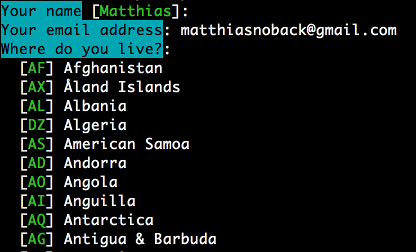Symfony Console Form
By Matthias Noback
This package contains a Symfony bundle and some tools which enable you to use Symfony Form types to define and interactively process user input from the CLI.
Installation
composer require matthiasnoback/symfony-console-form
Enable Matthias\SymfonyConsoleForm\Bundle\SymfonyConsoleFormBundle in the kernel of your Symfony application.
<?php
// app/AppKernel.php
public function registerBundles()
{
$bundles = array(
// ...
new Matthias\SymfonyConsoleForm\Bundle\SymfonyConsoleFormBundle(),
);
}Usage
Follow the steps below or just clone this project, then run:
php test/console.php form:demo
Set up the form
<?php
use Symfony\Component\Form\AbstractType;
use Symfony\Component\Form\FormBuilderInterface;
use Symfony\Component\OptionsResolver\OptionsResolverInterface;
use Symfony\Component\Validator\Constraints\Country;
use Symfony\Component\Validator\Constraints\Email;
class DemoType extends AbstractType
{
public function buildForm(FormBuilderInterface $builder, array $options)
{
$builder
->add(
'name',
'text',
[
'label' => 'Your name',
'required' => true,
'data' => 'Matthias'
]
)
...
;
}
public function setDefaultOptions(OptionsResolverInterface $resolver)
{
$resolver->setDefaults(['data_class' => 'Matthias\SymfonyConsoleForm\Tests\Data\Demo']);
}
public function getName()
{
return 'test';
}
}The corresponding Demo class looks like this:
<?php
class Demo
{
public $name;
...
}Create the console command
Strategy 1 (recommended): Use the form helper
<?php
use Symfony\Component\Console\Command\Command;
use Symfony\Component\Console\Input\InputInterface;
use Symfony\Component\Console\Output\OutputInterface;
use Matthias\SymfonyConsoleForm\Console\Helper\FormHelper;
class TestCommand extends Command
{
protected function configure()
{
$this->setName('form:demo');
}
protected function execute(InputInterface $input, OutputInterface $output)
{
$formHelper = $this->getHelper('form');
/** @var FormHelper $formHelper */
$formData = $formHelper->interactUsingForm(new DemoType(), $input, $output);
// $formData is the valid and populated form data object/array
...
}
}Strategy 2: implement FormBasedCommand
You could also implement FormBasedCommand:
<?php
use Symfony\Component\Console\Command\Command;
use Symfony\Component\Console\Input\InputInterface;
use Symfony\Component\Console\Output\OutputInterface;
use Matthias\SymfonyConsoleForm\Console\Command\FormBasedCommand;
use Matthias\SymfonyConsoleForm\Console\Command\FormBasedCommandCapabilities;
class TestCommand extends Command implements FormBasedCommand
{
// use this trait to prevent code duplication
use FormBasedCommandCapabilities;
protected function configure()
{
$this->setName('form:demo');
// you don't need to configure any options here, this is all taken care of
}
protected function formType()
{
// return the form type (can be a string) which should be used for interaction with the user
return new DemoType();
}
protected function execute(InputInterface $input, OutputInterface $output)
{
$formData = $this->formData();
// $formData is the valid and populated form data object/array
...
}
}Then run app/console form:demo and you'll see the following interaction:
The first strategy is preferred since it allows you to interact with different forms instead of just one form (as is the case when you pick the second strategy).
When you provide command-line options with the names of the form fields, those values will be used as default values.
If you add the --no-interaction option when running the command, it will submit the form using the input options you provided.
If the submitted data is invalid the command will fail.
TODO
- Provide example of stand-alone usage (no need to extend the command)
- Maybe: provide a way to submit a form at once, possibly using a JSON-encoded array
- Handle invalid form data (maybe in a loop)
- Add more functional tests
- Show form label of root form
- Show nesting in form hierarchy using breadcrumbs
- Show counter when looping through a collection form
- When these things have been provided, release this as a package (or multiple packages for stand-alone use)
